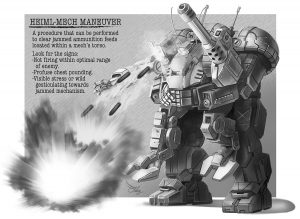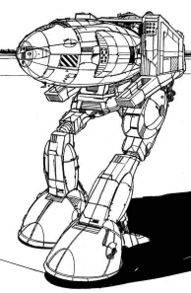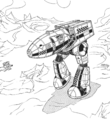Difference between revisions of "Stalker"
Sarna News

- Bad ‘Mechs - Sentinel
- HEXTECH Review - Wave 3 Brings More Urban Options To Your Battlefield
- Your BattleTech News Round-Up For March, 2024
- Crashing 'Mechs With Jennifer Brozek, Author Of The Rogue Academy Trilogy
- Getting The Word Out With Rem Alternis, Catalyst Community & Marketing Director
- Read more →
(Technical Readout: 3145 Free Worlds League - reminder - page 38) |
|||
| Line 56: | Line 56: | ||
===Custom Variants=== | ===Custom Variants=== | ||
* STK-3F ''Stalker Jagawen'' - Designed for close combat, the ''Stalker'' used by ''[[Sho-sho]]'' Jagawen Torisobo replaced the LRM launchers with an additional SRM-6 rack in each torso. Six additional heat sinks kept the machine cool. BV (2.0) = 1,570<ref>''Historical Turning Points: Misery'', p. 18</ref> | * STK-3F ''Stalker Jagawen'' - Designed for close combat, the ''Stalker'' used by ''[[Sho-sho]]'' Jagawen Torisobo replaced the LRM launchers with an additional SRM-6 rack in each torso. Six additional heat sinks kept the machine cool. BV (2.0) = 1,570<ref>''Historical Turning Points: Misery'', p. 18</ref> | ||
| + | |||
| + | * STK-3F ''Stalker Jamison'' - This variant is the personal 'Mech of [[J. Elliot Jamison]], commander of [[Wolf's Dragoons]]' [[Zeta Battalion]]. It was built as a Clantech version of the venerable STK-3F. The [[Large Laser]]s become [[Large Pulse Laser]] and its [[Medium Laser]]s are upgraded to [[ER medium laser]]s. A pair [[LRM-20]] are used instead of the original's ten-tube launchers. Rounding out the weapons array, two ammo efficient [[Streak SRM-6]]s are used. Eighteen clan double heat sinks are mounted to help control the heat load. Finally, ferro-fibrous armor is used to protect this dangerous BattleMech. BV (2.0) = 2707<ref>''Record Sheets: 3050 Unabridged (Inner Sphere)'' p. 250</ref> | ||
==Notable Pilots== | ==Notable Pilots== | ||
Revision as of 20:20, 16 August 2013
This article needs to be updated with material from Technical Readout: 3145 Free Worlds League. Once these titles clear the Moratorium period, or if they already have, please consider revisiting this article and updating it with the new material. |

| |
| Stalker | |
|---|---|
| Production information | |
| Manufacturer | Triad Technologies, Irian BattleMechs Unlimited, Trellshire Heavy Industries |
| Production Year | 2594[1][2] |
| Model | STK-3F |
| Class | Assault |
| Cost | 7,463,825 C-bills |
| Technical specifications | |
| Mass | 85 tons |
| Chassis | Titan H1 |
| Armor | Valiant Lamellor |
| Engine | Strand 255 |
| Communications System | Cronol PR |
| Speed | 54.0 km/h |
| Armament |
|
| BV (1.0) | 1,152 |
| BV (2.0) | 1,559[2] |
Contents
Description
The Stalker was first produced in 2594 as a heavy assault 'Mech for the Reunification War. The engineers and designers behind the Stalker built it to be a slow moving weapons platform capable of handling combat at any range. The 'Mech is built mounting weapons with overlapping ranges of fire that allow it to increase the amount of damage it can deal to an enemy 'Mech as it closes to shorter range. The Stalker is also commonly used to penetrate enemy lines and attack enemy hard points relying on its thick armor for protection. In this role the Stalker is an exceptional 'Mech that only has to worry about enemy units attempting to surround it and damage its weak rear armor.[2]
Armament
The Stalker's weapons assortment is built to increase damage as it closes with its target. The Stalker's long range weapons are two Jackson B5c LRM-10 launchers. These provide the Stalker with its longest-range punch and allow it to give indirect fire support when needed. At shorter range the Stalker next brings its two Magna Mk III Large Lasers to bear on its target. For close ranges, the Stalker carries four Magna Mk II Medium Lasers. Finally, it mounts two Thunderstroke SRM-6 launchers which enable it to take advantage of any weak spots in the enemy’s armor. The Stalker's largest problem lies in its heat management. It originally used a special computer to make the best use of its weaponry with regards to the heat it would generate. Unfortunately this program is now lost and a MechWarrior should stagger fire of its weapons to avoid overheating problems.[2]
Variants
- STK-3Fb - The 3Fb variant of the Stalker carries a Guardian ECM Suite in the center torso, upgrades the large lasers to extended range versions, and adds Artemis IV fire control systems to the LRM-15s that replace the Jackson LRM-10 launchers. The SRM-6 racks are gone, and the standard heat sinks were replaced with seventeen double heat sinks. BV (2.0) = 2,029[3]
- STK-3Fk - A unit used by the 4th Sword of Light, this variant of the Stalker replaces the heat sinks with Double Heat Sinks, adds Artemis IV FCS to the LRM 10 launchers, and replaces the SRM-6 packs with four Streak SRM-2 systems.[4]
- STK-3H - The 3H variant of the Stalker is built with long-range combat in mind. The 'Mech removes the two Large Lasers and the LRM-10 launchers and replaces them with two LRM-20 launchers. This makes the 3H a powerful long range fire support 'Mech. BV (1.0) = 1,249, BV (2.0) = 1,624[2]
- STK-4N - A modification of the Stalker that looks to increase its heat efficiency, the 4N model removes one of the LRM-10 launchers and adds six heat sinks to the design. These make the Stalker more heat efficient but also make the 'Mech weaker when engaging an enemy at long range. BV (1.0) = 1,225, BV (2.0) = 1,558[2]
- STK-4P - In earlier years, the Stalker commonly suffered structural weakness symptomatic of the extreme stress the 85 ton 'Mech's skeleton had to bear, necessitating the lightening of the load by a full ten tons. The 4P was a common solution to this problem; techs simply removed a single LRM-10 in order to keep an otherwise capable 'Mech in service. BV (1.0) = 1,126, BV (2.0) = 1,417[5]
- STK-5M - An upgrade originating from the Free Worlds League, the 5M variant of the Stalker uses moderate amounts of Star League technology. The seventeen double heat sinks of the 5M afford it far greater heat efficiency than the twenty single heat sinks of previous models. The communications system was changed to an Irian E.A.R.. The Large Lasers were removed, replaced with a single Diverse Optics Sunbeam ER Large Laser placed in the 'Mech's centerline and a Narc Missile Beacon. The beacon allows the Stalker to tag enemy units with homing beacons, allowing friendly 'Mechs to easily send missile salvos its way. Finally, the 'Mech bears an additional ton of armor for added survivability. BV (1.0) = 1,316, BV (2.0) = 1,655[6]
- STK-5S - Outfitted with the relatively recently rediscovered Star League technology of circa 3050, the 5S can be characterized primarily by its tendency to overheat. The designers behind this variant took the simple expedient of upgrading its engine and firepower without taking heat build-up into consideration. The 'Mech has had its engine replaced with an XL Engine and the Large Lasers have been removed and replaced with two Large Pulse Lasers. For protection against ammunition explosions, CASE has been added to both side torsos, and an Anti-Missile System has been added for protection against incoming missiles. BV (1.0) = 1,009, BV (2.0) = 1,423[7]
- STK-6M - Irian’s attempt to make up for the shortcomings of the 5M, the 6M drops the SRMs entirely, upgrades the LRMs to 15-tube racks with integral Artemis IV FCS, and upgrades the lasers to ER versions, mounting a fifth medium. Most importantly, the LRM magazines are now protected with CASE, BV (1.0) = ?, BV (2.0) = 2,029[citation needed]
- STK-7D - The 7D Stalker is built on a standard chassis and engine for rugged durability and carries a primarily energy arsenal. Its two primary weapons are two ER PPCs. These give the 7D a striking distance out to just under seven hundred meters. The 'Mech is also armed with four Medium Pulse Lasers for close combat, which are backed up by two Streak SRM-4 launchers to take advantage of any weak points in an enemy's armor. The lasers and ER PPCs are all linked to an advanced Targeting Computer, which gives the 7D extreme accuracy. BV (1.0) = 1,533[8], BV (2.0) = 1,901[7]
- STK-7C3BS - This Stalker variant uses several experimental systems. Its main armament is a pair of ER PPCs. These are supplemented by a pair of MML-5s and four Medium Pulse Lasers. A Small VSP Laser rounds out the weaponry. To communicate with its lancemates, this Stalker version uses a C3 Boosted Slave system. The MML ammunition is protected by CASE II systems. BV (2.0) = 1,712[9]
- STK-8S - The STK-8S is built around a new Light Fusion Engine which frees up some tonnage for heavier weapons. The 8S is armed with two ER PPCs for long-range combat. While it closes with an enemy it can bring its new Heavy Gauss Rifle to bear at intermediate to short ranges. Finally, for short range combat, the 8S carries two Medium Pulse Lasers and two ER Medium Lasers. BV (1.0) = 1,583[10], BV (2.0) = 2,020[7]
Custom Variants
- STK-3F Stalker Jagawen - Designed for close combat, the Stalker used by Sho-sho Jagawen Torisobo replaced the LRM launchers with an additional SRM-6 rack in each torso. Six additional heat sinks kept the machine cool. BV (2.0) = 1,570[11]
- STK-3F Stalker Jamison - This variant is the personal 'Mech of J. Elliot Jamison, commander of Wolf's Dragoons' Zeta Battalion. It was built as a Clantech version of the venerable STK-3F. The Large Lasers become Large Pulse Laser and its Medium Lasers are upgraded to ER medium lasers. A pair LRM-20 are used instead of the original's ten-tube launchers. Rounding out the weapons array, two ammo efficient Streak SRM-6s are used. Eighteen clan double heat sinks are mounted to help control the heat load. Finally, ferro-fibrous armor is used to protect this dangerous BattleMech. BV (2.0) = 2707[12]
Notable Pilots
- J. Elliot Jamison, commander of Wolf's Dragoons' Zeta Battalion piloted a Stalker for most of his career, serving with distinction during the Battle of Misery and the Fourth Succession War. [13]
- Major Tara Lucas of the Wolf's Dragoons' Zeta Battalion piloted a Stalker for much of her career until trading it in to pilot a state-of-the-art Clan OmniMech after the Clan Invasion of the 3050s.[citation needed]
Gallery
References
- ↑ Technical Readout: 3025, p. 116
- ↑ 2.0 2.1 2.2 2.3 2.4 2.5 Technical Readout: 3039, pp. 162-163
- ↑ Record Sheets: Operation Klondike, p. 51
- ↑ Era Report: 2750, p. 129
- ↑ Technical Readout: 3025, p. 116
- ↑ Technical Readout: 3050 Upgrade, p. 99
- ↑ 7.0 7.1 7.2 Master Unit List: Battle Values, p. 152
- ↑ Record Sheets: Upgrades, p. 140
- ↑ Record Sheets: 3085 Unabridged — Old is the New New, p. 112
- ↑ Record Sheets: Upgrades, p. 141
- ↑ Historical Turning Points: Misery, p. 18
- ↑ Record Sheets: 3050 Unabridged (Inner Sphere) p. 250
- ↑ Wolf's Dragoons (sourcebook) p. 98
Bibliography
- Era Report: 2750
- Historical Turning Points: Misery
- Master Unit List: Battle Values
- Record Sheets: 3025/3026
- Record Sheets: 3039
- Record Sheets: 3050
- Record Sheets: 3050 Upgrade (Inner Sphere)
- Record Sheets: 3085 Unabridged — Old is the New New
- Record Sheets: Upgrades
- Record Sheets: Operation Klondike
- Technical Readout: 3025
- Technical Readout: 3039
- Technical Readout: 3050
- Technical Readout: 3050 Revised
- Technical Readout: 3050 Upgrade
- Wolf's Dragoons (sourcebook)



